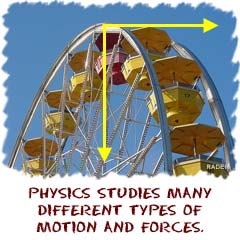 Motion is one of the key topics in physics. Everything in the universe moves. It might only be a small amount of movement and very very slow, but movement does happen. Don't forget that even if you appear to be standing still, the Earth is moving around the Sun, and the Sun is moving around our galaxy. The movement never stops. Motion is one part of what physicists callmechanics. Over the years, scientists have discovered several rules or lawsthat explain motion and the causes of changes in motion. There are also special laws when you reach the speed of light or when physicists look at very small things like atoms.
Motion is one of the key topics in physics. Everything in the universe moves. It might only be a small amount of movement and very very slow, but movement does happen. Don't forget that even if you appear to be standing still, the Earth is moving around the Sun, and the Sun is moving around our galaxy. The movement never stops. Motion is one part of what physicists callmechanics. Over the years, scientists have discovered several rules or lawsthat explain motion and the causes of changes in motion. There are also special laws when you reach the speed of light or when physicists look at very small things like atoms. Speed it Up, Slow it Down
The physics of motion is all about forces. Forces need to act upon an object to get it moving, or to change its motion. Changes in motion won't just happen on their own. So how is all of this motion measured? Physicists use some basic terms when they look at motion. How fast an object moves, its speed or Velocity, can be influenced by forces. (Note: Even though the terms 'speed' and 'velocity' are often used at the same time, they actually have different meanings.) Acceleration is a twist on the idea of velocity. Acceleration is a measure of how much the velocity of an object changes in a certain time (usually in one second). Velocities could either increase or decrease over time. Mass is another big idea in motion. Mass is the amount of something there is, and is measured in grams (or kilograms). A car has a greater mass than a baseball.
Acceleration is a twist on the idea of velocity. Acceleration is a measure of how much the velocity of an object changes in a certain time (usually in one second). Velocities could either increase or decrease over time. Mass is another big idea in motion. Mass is the amount of something there is, and is measured in grams (or kilograms). A car has a greater mass than a baseball. Simple and Complex Movement
There are two main ideas when you study mechanics. The first idea is that there are simple movements, such as if you're moving in a straight line, or if two objects are moving towards each other in a straight line. The simplest movement would be objects moving at constant velocity. Slightly more complicated studies would look at objects that speed up or slow down, where forces have to be acting.There are also more complex movements when an object's direction is changing. These would involve curved movements such as circular motion, or the motion of a ball being thrown through the air. For such complex motions to occur, forces must also be acting, but at angles to the movement.
In order to really understand motion, you have to think about forces, acceleration, energy, work, and mass. These are all a part of mechanics.







0 comments:
Post a Comment